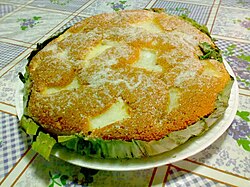Bibingka

A large bibingka topped with grated coconut
|
|
| Course | Dessert, breakfast |
|---|---|
| Place of origin | Philippines |
| Serving temperature | Hot or warm |
| Main ingredients | Rice flour, water or coconut milk |
| Variations | Bibingka Galapong, Bibingkang Malagkit, Cassava Bibingka, Bibingkang Mandaue |
| |
|
Bibingka is a type of rice cake from the Philippines usually eaten during the Christmas season. It is traditionally cooked in clay pots lined with banana leaves.
Bibingka is made with rice flour and coconut milk or water. Other ingredients can vary greatly, but the most common secondary ingredients are eggs and milk. The traditional preparation is very time-consuming. A specially made terra cotta container is lined with a single large section of a banana leaf. It is placed over preheated coals and the rice flour and water mixture is poured into it, taking care not to spill it into the container itself. Another piece of banana leaf is added to the top and covered with more preheated coals.
The end result is a soft and spongy large flat cake that is slightly charred on both surfaces and infused with the unique aroma of toasted banana leaves. Toppings are then added, usually consisting of butter/margarine, sugar, cheese, or grated coconut. Other more uncommon toppings include pinipig (pounded immature rice grains), pineapple, and salted duck eggs. A mixture of two or more of these toppings on a single bibingka are also common. Bibingka with sumptuous amounts of toppings (and ingredients) are sometimes called bibingka especial.
More modern methods involve bibingka being baked in an actual oven inside a caldero or ordinary cake pans. The result lacks the distinctive smoky smell of charcoal but is otherwise the same, especially if banana leaves are also used to line it. Mass-produced bibingka in Philippine bakeries are also made using characteristic tin molds that give them a crenelated shape similar to large puto or puto mamon (cupcakes).
Bibingka is best served hot. Large bibingka can be sliced (or torn) into several wedges and can serve 4 to 6 people.
Bibingka has a soft spongy texture similar to puto, another Philippine rice cake. It is eaten hot or warm and is slightly sweet with a taste very similar to rice pudding. The top and bottom surfaces (including the traditional banana leaf lining) are also usually charred, adding to the flavor.
...
Wikipedia
